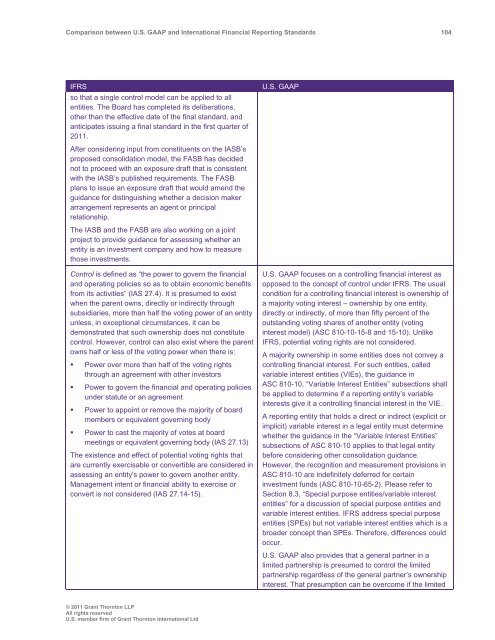Comparison between U.S. GAAP and International ... - Grant Thornton
Comparison between U.S. GAAP and International ... - Grant Thornton
Comparison between U.S. GAAP and International ... - Grant Thornton
Create successful ePaper yourself
Turn your PDF publications into a flip-book with our unique Google optimized e-Paper software.
<strong>Comparison</strong> <strong>between</strong> U.S. <strong>GAAP</strong> <strong>and</strong> <strong>International</strong> Financial Reporting St<strong>and</strong>ards 104<br />
IFRS<br />
so that a single control model can be applied to all<br />
entities. The Board has completed its deliberations,<br />
other than the effective date of the final st<strong>and</strong>ard, <strong>and</strong><br />
anticipates issuing a final st<strong>and</strong>ard in the first quarter of<br />
2011.<br />
After considering input from constituents on the IASB’s<br />
proposed consolidation model, the FASB has decided<br />
not to proceed with an exposure draft that is consistent<br />
with the IASB’s published requirements. The FASB<br />
plans to issue an exposure draft that would amend the<br />
guidance for distinguishing whether a decision maker<br />
arrangement represents an agent or principal<br />
relationship.<br />
The IASB <strong>and</strong> the FASB are also working on a joint<br />
project to provide guidance for assessing whether an<br />
entity is an investment company <strong>and</strong> how to measure<br />
those investments.<br />
Control is defined as “the power to govern the financial<br />
<strong>and</strong> operating policies so as to obtain economic benefits<br />
from its activities” (IAS 27.4). It is presumed to exist<br />
when the parent owns, directly or indirectly through<br />
subsidiaries, more than half the voting power of an entity<br />
unless, in exceptional circumstances, it can be<br />
demonstrated that such ownership does not constitute<br />
control. However, control can also exist where the parent<br />
owns half or less of the voting power when there is:<br />
• Power over more than half of the voting rights<br />
through an agreement with other investors<br />
• Power to govern the financial <strong>and</strong> operating policies<br />
under statute or an agreement<br />
• Power to appoint or remove the majority of board<br />
members or equivalent governing body<br />
• Power to cast the majority of votes at board<br />
meetings or equivalent governing body (IAS 27.13)<br />
The existence <strong>and</strong> effect of potential voting rights that<br />
are currently exercisable or convertible are considered in<br />
assessing an entity's power to govern another entity.<br />
Management intent or financial ability to exercise or<br />
convert is not considered (IAS 27.14-15).<br />
U.S. <strong>GAAP</strong><br />
U.S. <strong>GAAP</strong> focuses on a controlling financial interest as<br />
opposed to the concept of control under IFRS. The usual<br />
condition for a controlling financial interest is ownership of<br />
a majority voting interest – ownership by one entity,<br />
directly or indirectly, of more than fifty percent of the<br />
outst<strong>and</strong>ing voting shares of another entity (voting<br />
interest model) (ASC 810-10-15-8 <strong>and</strong> 15-10). Unlike<br />
IFRS, potential voting rights are not considered.<br />
A majority ownership in some entities does not convey a<br />
controlling financial interest. For such entities, called<br />
variable interest entities (VIEs), the guidance in<br />
ASC 810-10, “Variable Interest Entities” subsections shall<br />
be applied to determine if a reporting entity’s variable<br />
interests give it a controlling financial interest in the VIE.<br />
A reporting entity that holds a direct or indirect (explicit or<br />
implicit) variable interest in a legal entity must determine<br />
whether the guidance in the “Variable Interest Entities”<br />
subsections of ASC 810-10 applies to that legal entity<br />
before considering other consolidation guidance.<br />
However, the recognition <strong>and</strong> measurement provisions in<br />
ASC 810-10 are indefinitely deferred for certain<br />
investment funds (ASC 810-10-65-2). Please refer to<br />
Section 8.3, “Special purpose entities/variable interest<br />
entities” for a discussion of special purpose entities <strong>and</strong><br />
variable interest entities. IFRS address special purpose<br />
entities (SPEs) but not variable interest entities which is a<br />
broader concept than SPEs. Therefore, differences could<br />
occur.<br />
U.S. <strong>GAAP</strong> also provides that a general partner in a<br />
limited partnership is presumed to control the limited<br />
partnership regardless of the general partner’s ownership<br />
interest. That presumption can be overcome if the limited<br />
© 2011 <strong>Grant</strong> <strong>Thornton</strong> LLP<br />
All rights reserved<br />
U.S. member firm of <strong>Grant</strong> <strong>Thornton</strong> <strong>International</strong> Ltd
















